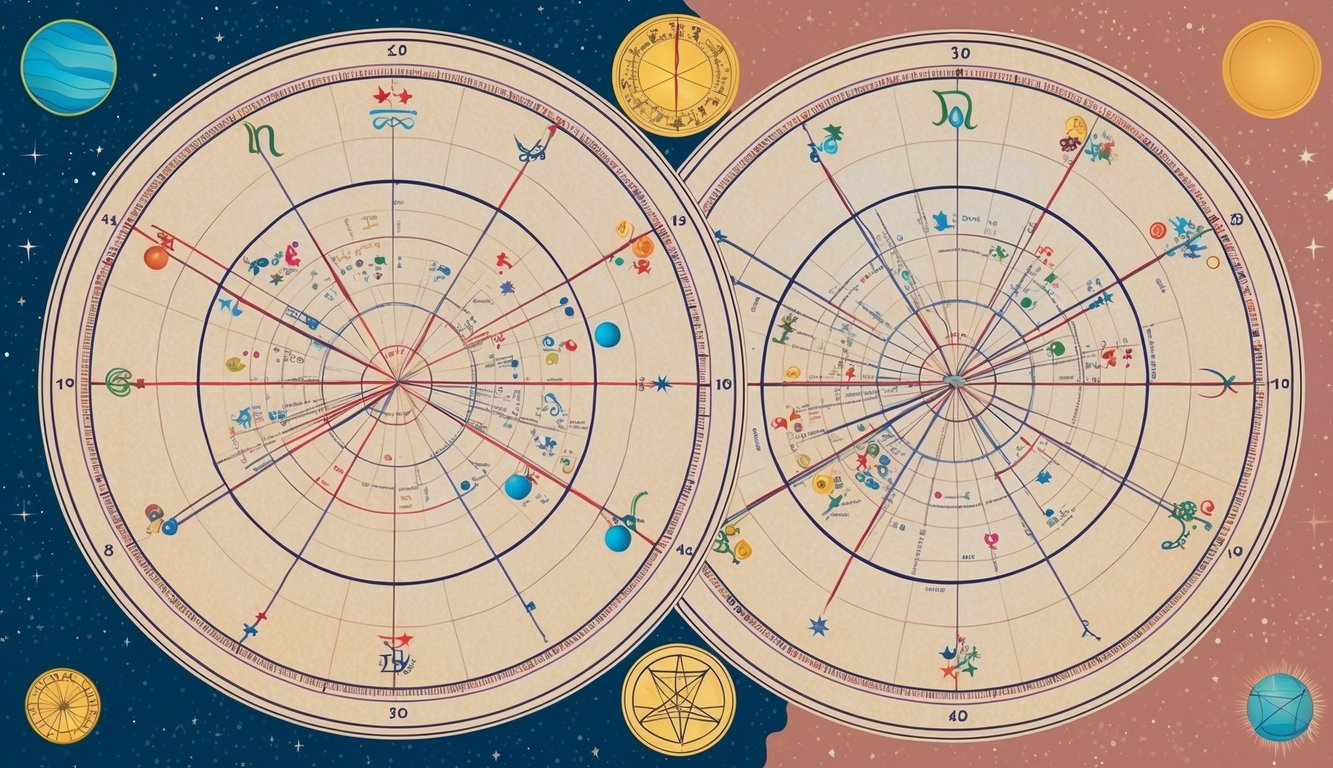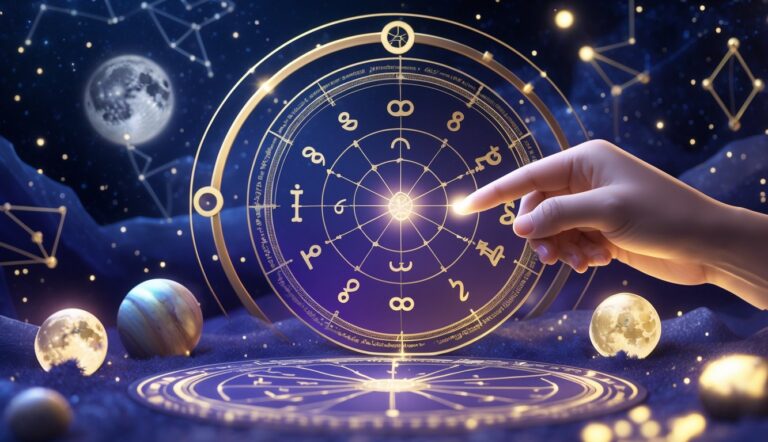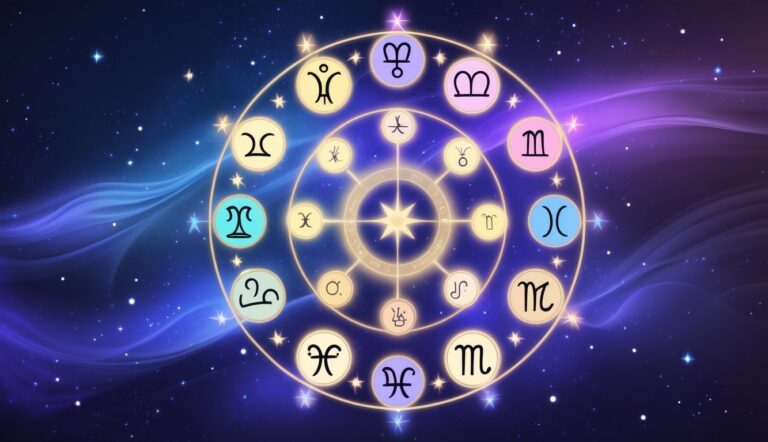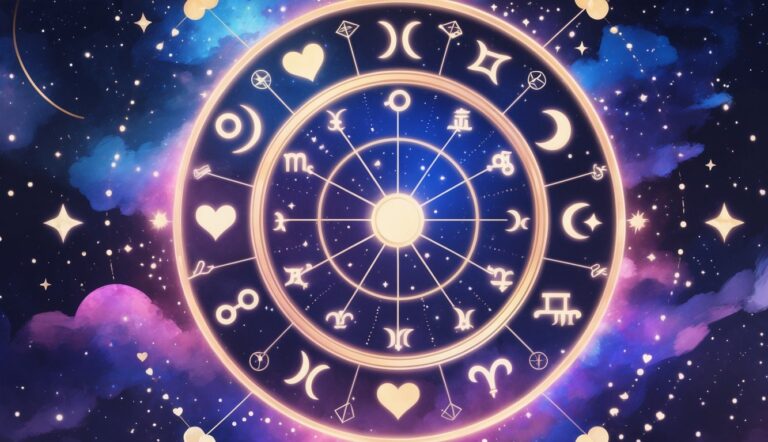Align Your Life with Your True North
The Power Quadrant System decodes your natural talents and pinpoints the career, timing and relationships that let you earn more, love deeper, and wake up eager for the day.
- Uncover your #1 high-income strength
- Draw in partners who raise your energy
- Work when your body’s clock is in “flow”
Have you ever looked at your birth chart and wondered what all those lines and angles mean? They’re called aspects, and they’re a key part of astrology.
Aspects show how the planets in your chart connect and interact with each other.
These connections shape your personality, relationships, and life path.
Aspects come in different flavors.
Some are easy and flowing, like trines and sextiles.
Others are more challenging, like squares and oppositions.
Each type of aspect brings its own energy to your chart.
For example, a trine between your Sun and Moon might make you feel balanced and at ease with yourself.
A square between Mars and Saturn could give you drive but also some frustration.
Understanding aspects can help you make sense of your zodiac signs and how they work together.
It’s like seeing the big picture of your astrological makeup.
You might find out why you’re drawn to certain people or why some areas of life come naturally to you.
Decode Your Personal Success Blueprint
Power Quadrant System shows you the exact career, relationships, and daily rhythm that match your natural DNA—so you earn more, work happier, and connect deeper.
- Pinpoint your #1 money-making talent
- Erase conflict & attract ideal partners
- Multiply productivity with perfect timing
Aspects add depth to your horoscope, giving you more insight into who you are and what makes you tick.
Understanding Astrology Aspects
Astrology aspects are key to grasping how planets interact in your birth chart.
They’re like cosmic conversations between celestial bodies.
Aspects are angles between planets.
The main ones you’ll come across are:
- Conjunct (0°): Planets are super close, blending energies
- Opposition (180°): Planets face off, creating tension
- Square (90°): Challenging angle that sparks growth
- Trine (120°): Harmony and easy flow between planets
- Sextile (60°): Gentle, positive vibes
These angles shape how planetary energies mix and match in your chart.
Think of them as cosmic dance partners!
Planetary aspects can be soft (easy) or hard (challenging).
Tap Into Your Built-In Success GPS
The Power Quadrant System deciphers your genetic blueprint so you can lock onto the career, income and relationships that feel effortless—and wildly rewarding.
- Zero in on your natural high-earning genius
- Sync with partners who boost your vibe
- Wake up driven, finish days fulfilled
Soft aspects like trines and sextiles bring smooth sailing.
Hard ones like squares and oppositions might ruffle your feathers but lead to personal growth.
Remember, aspects have “orbs” – wiggle room in their exact angles.
A wider orb means the aspect’s influence is less intense.
By understanding aspects, you’ll get a clearer picture of how planets play together in your chart.
It’s like decoding your personal astrological puzzle!
The Major Aspects Explained
The major aspects in astrology shape how planets interact in your birth chart.
These key relationships between celestial bodies influence different areas of your life.
Let’s explore the five main aspects and what they mean for you.
The Conjunction Aspect
A conjunction happens when two planets are very close together in your chart.
This aspect blends the energies of the planets involved.
It’s like they’re working as a team.
Conjunctions can be powerful.
They concentrate planetary forces in one area of your life.
This can be good or challenging, depending on which planets meet up.
For example, if Venus and Mars join forces, you might have a passionate approach to love.
But a Sun-Saturn conjunction could mean you take life very seriously.
The Opposition Aspect
An opposition occurs when planets are across from each other in your chart.
This creates tension between the energies involved.
It’s like a tug-of-war between two parts of your life.
Oppositions can lead to inner conflict.
But they also offer a chance for balance.
You might struggle to choose between two different paths.
For instance, a Moon-Mars opposition could mean your emotions and actions don’t always line up.
You might feel one way but act another.
The Square Aspect
Squares happen when planets are 90 degrees apart in your chart.
This aspect brings friction and challenges.
It’s like two planets are butting heads.
Squares push you to take action.
They can be stressful, but they also help you grow.
You might face obstacles related to the planets involved.
A Mercury-Jupiter square could mean your ideas are big, but you struggle to express them clearly.
This aspect might push you to improve your communication skills.
The Trine Aspect
Trines occur when planets are 120 degrees apart.
This is a harmonious aspect.
It’s like the planets are working together smoothly.
Trines bring ease and flow to your life.
They show areas where things come naturally to you.
But sometimes this can make you lazy in these areas.
A Sun-Neptune trine might give you a vivid imagination and strong intuition.
You might be naturally creative or spiritual without much effort.
The Sextile Aspect
Sextiles happen when planets are 60 degrees apart.
This is another friendly aspect, but it’s not as strong as a trine.
It’s like the planets are giving each other a helping hand.
Sextiles offer opportunities for growth.
They show areas where you can easily learn and improve.
But you need to put in some effort to use them.
A Venus-Mars sextile could mean you have the potential to balance love and passion well.
With a little work, you might create very harmonious relationships.
The Planets and Their Aspects
Planets make different angles to each other as they move through the zodiac.
These angles, called aspects, shape how the planets’ energies mix and affect you.
Let’s look at how aspects to each planet can impact different parts of your life.
Sun Aspects and Personality
Your Sun sign represents your core self.
When other planets form aspects to your Sun, it affects how you express yourself.
Sun-Moon aspects influence how your inner and outer selves align.
A harmonious trine helps you feel at ease with yourself.
A tense square may create inner conflict.
Sun-Mercury aspects shape how you think and communicate.
A conjunction gives you a clear, focused mind.
An opposition can make it hard to express your thoughts.
Sun-Venus aspects color your social side.
A sextile boosts your charm.
A square might make you shy in social settings.
Sun-Mars aspects impact your drive.
A trine gives you lots of energy.
A square could make you feel frustrated or angry.
Moon Aspects and Emotions
Your Moon sign shows your emotional nature.
Aspects to the Moon affect your feelings and reactions.
Moon-Mercury aspects link emotions and thoughts.
A trine helps you express your feelings well.
A square might make you overthink your emotions.
Moon-Venus aspects shape how you give and receive love.
A sextile helps you feel cherished.
An opposition can make relationships tricky.
Moon-Mars aspects influence your emotional responses.
A trine gives you courage.
A square might make you react too quickly.
Moon-Jupiter aspects affect your inner growth.
A conjunction expands your emotional world.
A square can make you overreact.
Mercury Aspects and Communication
Mercury rules how you think and speak.
Its aspects affect your mental skills and interactions.
Mercury-Venus aspects shape your social communication.
A trine makes you a smooth talker.
A square might cause misunderstandings.
Mercury-Mars aspects influence how you argue.
A sextile helps you debate well.
An opposition can make you too blunt.
Mercury-Jupiter aspects expand your mind.
A conjunction gives you big ideas.
A square might make you promise too much.
Mercury-Saturn aspects affect your focus.
A trine helps you concentrate.
A square can make you doubt yourself.
Venus Aspects and Love
Venus governs love and beauty.
Its aspects shape your romantic life and tastes.
Venus-Mars aspects influence passion.
A trine creates sparks.
A square might cause conflict in relationships.
Venus-Jupiter aspects affect how you show affection.
A sextile makes you generous.
An opposition can lead to overdoing it.
Venus-Saturn aspects shape commitment.
A trine helps build lasting bonds.
A square might make you fear getting close.
Venus-Neptune aspects color your romantic ideals.
A conjunction brings magic to love.
A square can lead to unrealistic expectations.
Mars Aspects and Drive
Mars represents your energy and ambition.
Its aspects affect how you pursue your goals.
Mars-Jupiter aspects boost your drive.
A trine gives you confidence.
A square might make you take on too much.
Mars-Saturn aspects test your endurance.
A sextile helps you work hard.
An opposition can make you feel blocked.
Mars-Uranus aspects bring surprises.
A trine sparks exciting changes.
A square might cause sudden outbursts.
Mars-Pluto aspects intensify your will.
A conjunction gives you incredible focus.
A square can lead to power struggles.
Jupiter Aspects and Growth
Jupiter brings luck and expansion.
Its aspects shape how you grow and find meaning.
Jupiter-Saturn aspects balance optimism and caution.
A trine helps you plan wisely.
A square might make you doubt your path.
Jupiter-Uranus aspects bring sudden opportunities.
A sextile opens new doors.
An opposition can cause restlessness.
Jupiter-Neptune aspects inspire your dreams.
A trine fuels your imagination.
A square might lead to unrealistic hopes.
Jupiter-Pluto aspects transform your worldview.
A conjunction deepens your beliefs.
A square can cause conflicts over ideals.
Saturn Aspects and Structure
Saturn represents limits and lessons.
Its aspects shape how you handle responsibility.
Saturn-Uranus aspects balance tradition and change.
A trine helps you update old systems.
A square can cause tension between old and new.
Saturn-Neptune aspects test your ideals.
A sextile helps you make dreams real.
An opposition might make you doubt your vision.
Saturn-Pluto aspects reshape your foundations.
A trine helps you rebuild stronger.
A square can force major life changes.
Uranus Aspects and Innovation
Uranus brings sudden changes and new ideas.
Its aspects shape how you experience surprises.
Uranus-Neptune aspects spark creativity.
A trine inspires unique visions.
A square might blur the line between fantasy and reality.
Uranus-Pluto aspects drive big changes.
A sextile helps you transform positively.
An opposition can cause upheaval.
Neptune Aspects and Dreams
Neptune rules imagination and spirituality.
Its aspects shape your inner world.
Neptune-Pluto aspects deepen your intuition.
A trine enhances psychic abilities.
A square might make it hard to tell truth from illusion.
Pluto Aspects and Power
Pluto governs transformation and hidden truths.
Its aspects shape how you deal with intensity.
Pluto’s aspects to personal planets can be life-changing.
They often bring deep healing and growth, even if the process is challenging.
Minor Aspects and Their Influence
Minor aspects in astrology add depth to your birth chart.
They reveal subtle energies that shape your personality and life experiences.
Let’s explore six important minor aspects and how they affect you.
The Semisextile Aspect
The semisextile occurs when planets are 30 degrees apart.
It creates a gentle push for growth in your life.
This aspect can make you feel slightly uneasy, but in a good way.
It nudges you to make small changes.
You might find yourself drawn to new interests or skills.
The semisextile helps you connect different parts of your personality.
It’s like a soft whisper, encouraging you to step out of your comfort zone.
This aspect often brings unexpected opportunities.
You may meet people who introduce you to fresh ideas.
Pay attention to these chances – they could lead to personal growth.
The Semisquare Aspect
When planets form a 45-degree angle, it’s called a semisquare.
This aspect can create inner tension in your life.
It’s like an itch you can’t quite scratch.
You might feel frustrated or restless.
The semisquare pushes you to take action, even when it’s uncomfortable.
It highlights areas where you need to make changes.
This aspect can bring challenges, but they help you grow.
You may face obstacles that test your patience.
By working through these issues, you become stronger and more resilient.
The Sesquisquare Aspect
The sesquisquare, or sesquiquadrate, occurs when planets are 135 degrees apart.
This aspect can bring sudden changes or surprises to your life.
It’s like a wake-up call that shakes things up.
This aspect can make you experience unexpected events that force you to adapt.
You might also feel on edge or anxious.
But it also gives you the energy to overcome challenges.
You might also feel on edge or anxious.
But it also gives you the energy to overcome challenges.
You might experience unexpected events that force you to adapt.
The sesquisquare can make you feel on edge or anxious.
But it also gives you the energy to overcome challenges.
This aspect pushes you out of your comfort zone.
It may lead to breakthroughs in areas where you’ve been stuck.
Embrace the changes – they often lead to personal growth and new opportunities.
The Quintile Aspect
Planets at a 72-degree angle form a quintile.
This aspect brings creativity and talent into your life.
It’s like a spark of inspiration that lights up your world.
You may discover hidden abilities or interests.
The quintile helps you see things from a unique perspective.
It can make you feel more confident in your skills.
This aspect can also lead to moments of brilliance.
You might come up with innovative solutions to problems.
Pay attention to your intuition – it’s especially strong under this influence.
The Biquintile Aspect
The biquintile occurs when planets are 144 degrees apart.
It enhances your ability to express yourself creatively.
This aspect is like a bridge between your inner world and the outside world.
You may find it easier to share your ideas with others.
The biquintile helps you see connections that others miss.
It can make you feel more in tune with your surroundings.
This aspect can also bring moments of insight or revelation.
You might suddenly understand complex concepts.
Use this energy to explore new ways of thinking and creating.
The Quincunx Aspect
Also known as the inconjunct, the quincunx forms when planets are 150 degrees apart.
This aspect can create a sense of unease or tension in your life.
It’s like trying to fit a square peg in a round hole.
You might struggle to integrate different parts of your personality.
The quincunx challenges you to find balance and make adjustments.
It can make you feel uncomfortable, but it also spurs growth.
This aspect often leads to personal breakthroughs.
By working through the tension, you develop new skills and perspectives.
Embrace the awkwardness – it’s a sign that you’re evolving.
Aspect Patterns and Configurations
When you look at an astrology chart, you’ll notice lines connecting different planets.
These lines form shapes called aspect patterns.
They give clues about how the energies of planets work together in your life.
One common pattern is the grand trine.
It looks like a triangle in your chart.
This pattern shows areas where things come easily to you.
It’s like having natural talents!
Another interesting shape is the yod.
It looks like an arrow or finger pointing at one planet.
This can show an area of your life that needs extra focus or development.
The grand cross forms a big X in your chart.
It can bring challenges, but also the chance to grow.
Think of it as life giving you opportunities to become stronger.
A T-square looks like half of the grand cross.
It shows where you might face some friction, but it also pushes you to take action.
Sometimes planets bunch up in one area of your chart.
This is called a stellium.
It highlights an important part of your personality or life experience.
These patterns help you understand the big picture of your chart.
They show how different parts of your life and personality connect and influence each other.
The Role of Elements and Modalities
Elements and modalities are key parts of astrology.
They help explain how zodiac signs act and feel.
There are four elements: fire, earth, air, and water.
Each sign belongs to one of these groups.
Fire signs are passionate and energetic.
Earth signs are practical and grounded.
Air signs are thoughtful and communicative.
Water signs are emotional and intuitive.
Modalities describe how signs express their energy.
There are three types:
- Cardinal – These signs like to start new things
- Fixed – These signs are steady and resistant to change
- Mutable – These signs are flexible and adaptable
Every zodiac sign is a mix of one element and one modality.
This combo shapes how you act and react to life.
For example, Aries is a cardinal fire sign.
This makes you bold and eager to take action.
Taurus is a fixed earth sign, so you’re likely patient and stubborn.
Understanding these traits can help you know yourself better.
It can also improve how you relate to others with different element and modality combos.
Aspects in Synastry
Synastry is all about how your planets interact with your partner’s. It’s like a cosmic dance between two birth charts!
The main aspects to look at are conjunctions, squares, trines, and oppositions.
These show how your energies mix and match.
Conjunctions are when planets are close together.
They can create intense connections, for better or worse.
For example, if your Sun conjuncts your partner’s Moon, you might feel a deep bond.
Trines and sextiles are usually easy-flowing aspects.
They show areas where you naturally get along.
Venus trine Jupiter could mean lots of fun and affection in your relationship.
Squares and oppositions can bring challenges, but also growth.
These aspects may show where you need to work things out together.
Some key planets to check in synastry:
- Sun and Moon for basic compatibility
- Venus and Mars for romance and attraction
- Mercury for communication
- Saturn for long-term potential
Remember, no single aspect makes or breaks a relationship.
It’s the whole picture that counts!
You can use synastry to understand your dynamics better.
It might explain why you click in some areas and clash in others.
But don’t forget – you’re not limited by the stars.
Your choices and efforts matter too!
Astrological Houses and Aspects
Astrology charts have 12 houses that represent different areas of your life.
These houses work with the planets and zodiac signs to tell your unique story.
The houses start with the ascendant, or rising sign, which is the sign on the eastern horizon when you were born.
This first house relates to your identity and how others see you.
Another important angle is the midheaven at the top of your chart.
It’s linked to your career and public image.
Each house has its own themes:
- 1st: Self and appearance
- 2nd: Money and values
- 3rd: Communication and siblings
- 4th: Home and family
- 5th: Creativity and romance
- 6th: Health and daily routines
The rest of the houses cover relationships, shared resources, travel, career, friendships, and your inner world.
Aspects show how planets in different houses interact.
For example, planets in your 7th house of partnerships might form helpful or challenging angles with planets in your 10th house of career.
By looking at house placements and aspects, you can gain insights into different parts of your life and how they connect.
Transits and Progressions
Transits and progressions are two key tools in astrology.
They help you understand how the planets affect your life over time.
Transits show where planets are right now.
They’re like a snapshot of the sky at this moment.
You can compare these current planets to your natal chart.
This helps you see how they might impact you.
Progressions are different.
They’re like a slow-motion version of your natal chart.
Each day after your birth equals about a year of your life.
This shows how your chart grows and changes as you do.
Here’s a quick comparison:
Transits:
- Show current planetary positions
- Change quickly
- Help predict short-term events
Progressions:
- Show your chart’s evolution
- Change slowly
- Help understand long-term growth
When you look at both, you get a fuller picture.
Transits might explain why you’re feeling a certain way today.
Progressions can show bigger life themes.
Try tracking both for a while.
You might notice patterns in how transiting aspects affect you.
Over time, you’ll see how progressions reflect your personal growth.
Remember, these tools are meant to guide you.
They don’t control your life.
You always have the power to make your own choices.
Interpreting Aspects in Your Birth Chart
Your birth chart holds a treasure trove of info about you.
It’s like a snapshot of the sky when you were born.
The aspects in your chart show how the planets talk to each other.
To start reading your aspects, look for lines connecting planets.
These lines show the angles between them.
Each angle means something different.
Here are the main aspects to watch for:
- Conjunctions: Planets right next to each other (0°)
- Squares: Planets at a 90° angle
- Trines: Planets at a 120° angle
- Oppositions: Planets across from each other (180°)
Conjunctions and trines are usually seen as good.
They show areas where things come easily to you.
On the other hand, squares and oppositions can be trickier.
They point to places where you might face challenges.
Don’t worry if you see “hard” aspects.
They can help you grow.
Think of them as chances to learn and get stronger.
As you look at your aspects, ask yourself:
- What planets are involved?
- What houses are they in?
- How might these energies play out in your life?
Remember, your birth chart is a tool for self-awareness.
It can help you understand your strengths and growth areas.
Use it as a guide on your personal journey.












